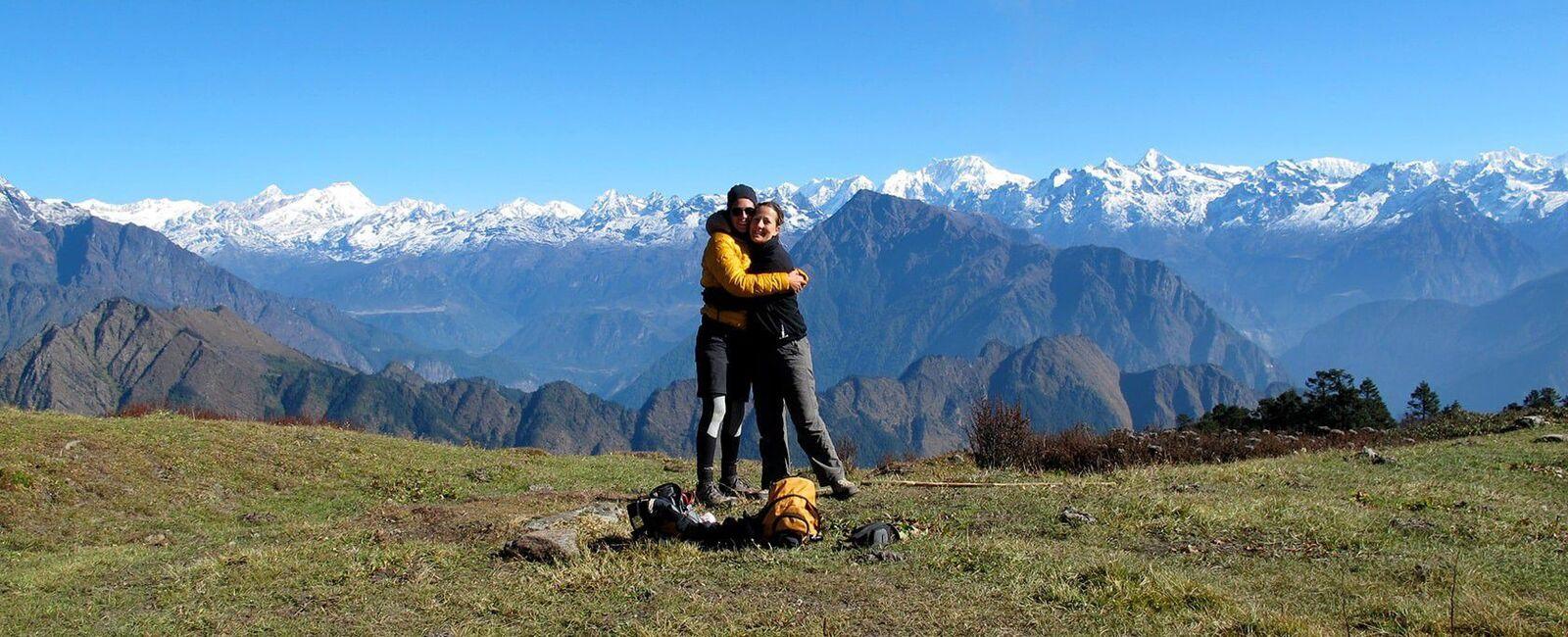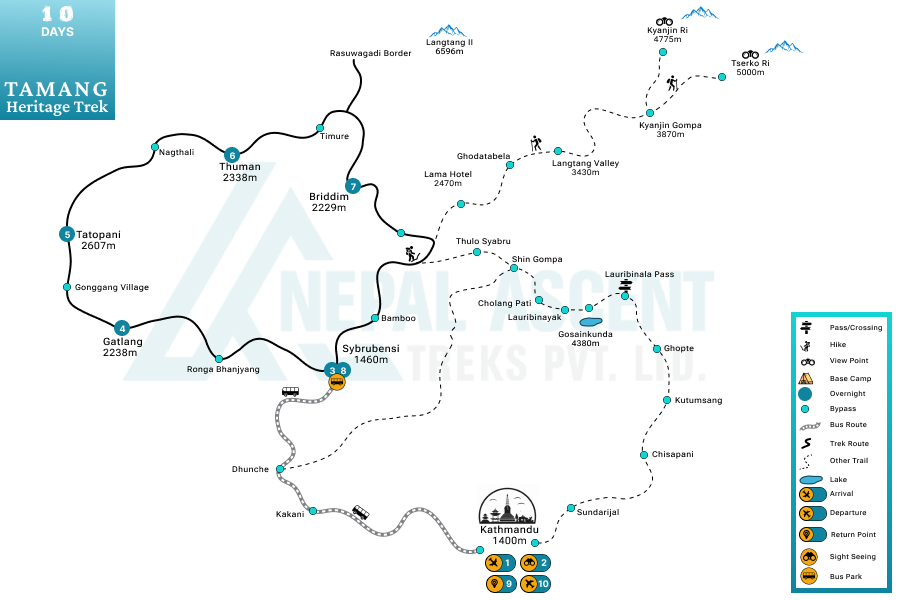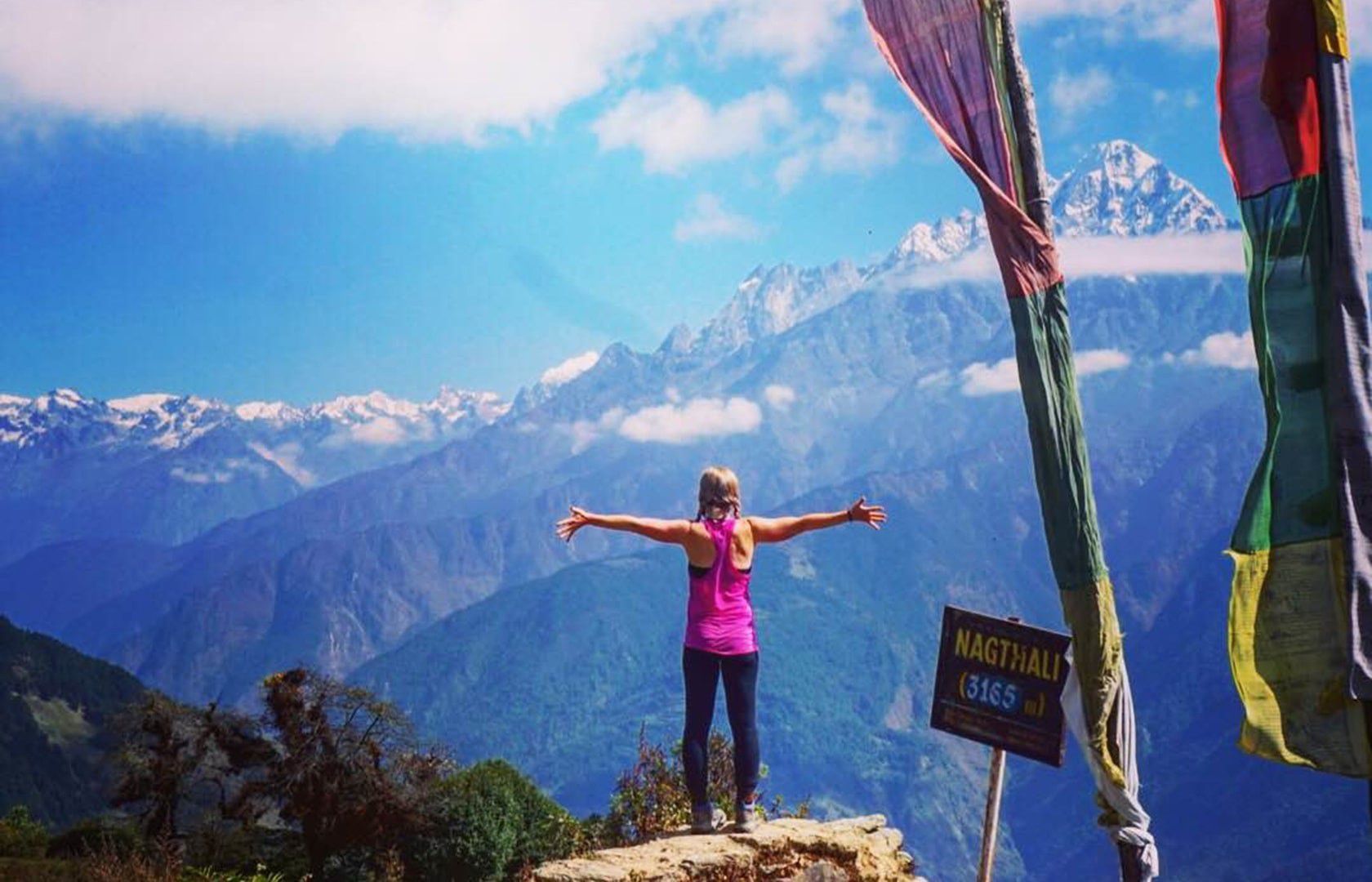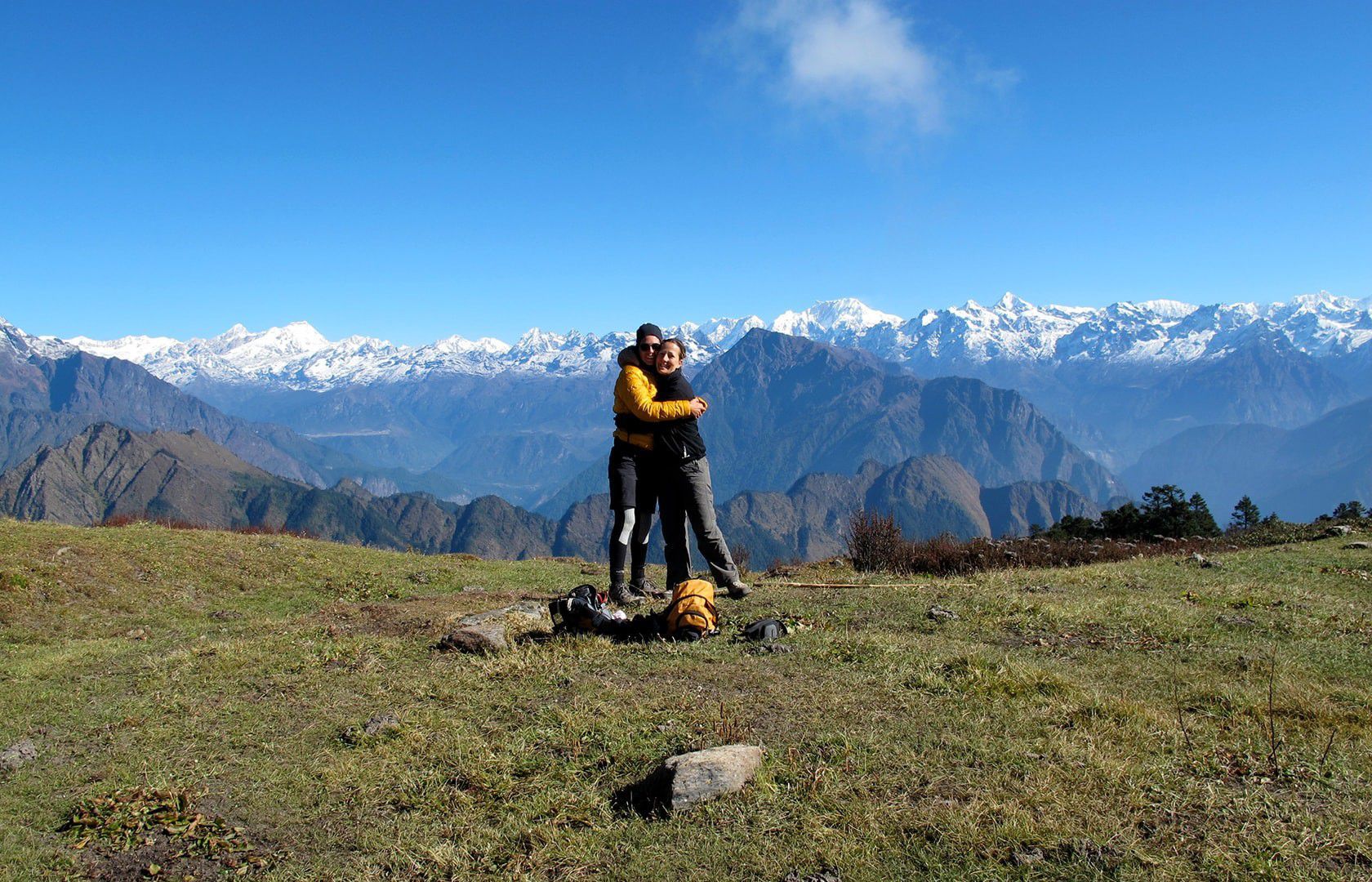
Tamang Heritage Trek
- Tripadvisor 4.96 (from 243+ reviews)
- Competitive Price
- 100% Guaranteed Departures
- Expert Local Guides
Trip Information
Trip Duration
9 Nights 10 Days
Difficulty Level
Easy
Destination
Nepal
Maximum Height
2338 m
Guiding Method
Trekking
Best Season
All Time
Highlights
- Explore the beautiful Tamang village of Gatlang.
- Feel the warmth of Tamang people in the villages of Thuman and Bridim,and Tibetan tradition.
- Affords splendid view of the stunning peak of Langtang Himal.
- Take in stunning views of Ganish Himal and Langtang Himal from Nagthali view point.
- Take a bath in the natural hot spring at Tatopani.
The Tamang Heritage trek is about trekking through the trail in Langtang that was previously not allowed to trek for the public. The word “Tamang” is named after an indigenous group of Mongolian tribe that mostly populates the region. The trek takes us through many villages in the region where you get to observe traditional cultural lifestyle and way of living of Tamang people. You get close to them and try to understand the traditional culture and lifestyle. The rich culture makes them special and unique. Also, there are farmlands where the people work on. People are found to be rearing different domestic animals as well.
There are very few settlement areas and sparse vegetation when we reach the higher altitudes. People rear yaks for dairy products and there are also cheese factories in the region. We can see people transporting goods through donkeys and mules as there is no transportation available and no proper roads built. People are mostly involved in hotel business sector. There are stone built teahouses, lodges and restaurants at different resting places. We take rest, have our lunch and stay for the night at tea houses along our way. The teahouses are built around the region to cater to the visitors. We can also visit many temples and monasteries along the way. Another interesting part of this trek is enjoying hot springs at Tatopani.
The trek takes you closer to the exquisite natural beauty of hilly landscapes and through beautiful valleys and dense rhododendron forests. Also, some wild animals can be spotted around the forest area. You can also have some glimpses mountain peaks peeking through the green hills.
Route Map

Altitude Graph
Itinerary
Upon your arrival at Tribhuvan International Airport, we offer you pick up facility from the airport and manage your stay at the most comfortable hotel in the city. You get to meet the team of trekkers and together we prepare for the trek. At the evening we offer you lavish welcome dinner with authentic Nepali Cuisine.
Accommodation
3 Star Hotel
Meal
Dinner
Transportation
Private car
We offer you a short trip to historical and cultural sites around Kathmandu valley: Boudhanath Stupa, Swayambhunath Stupa and Pashupatinath temple. You can also do some souvenir shopping during the sightseeing. After sightseeing, we head back to the hotel and get our clothing and trekking equipment ready and prepare for the trek.
Accommodation
3 Star Hotel
Meal
Breakfast
Transportation
Private car
We start our journey from Kathmandu and head north. We take a break at Trishuli Bazar and again head toward Dhunche enjoying the view of green hills and dense forests around. We might get a chance to have a glimpse of Ganesh Himal, Annapurna and Manaslu if the weather is favourable. Finally, upon reaching Syabrubesi we take rest and spend the night there.
Accommodation
Basic Teahouse / Lodge
Meal
Breakfast | Lunch | Dinner
Transportation
Public bus
Our trek begins today with the walk starting from Syabrubesi. From there we catch the uphill trail. The trail leads us to a high point from where we can have a great view of Ganesh Himal, Goljang valley and Gosaikunda range. Starting with here, we stroll up towards Gatlang following the trail accompanied by Chortens, Mani walls, and a small settlement. After walking for about 3 hours we finally reach a beautiful Tamang village of Gatlang. The remaining day is spent exploring the village. The night will be spent at a lodge in Gatlang.
Accommodation
Basic Teahouse / Lodge
Meal
Breakfast | Lunch | Dinner
Transportation
Walking
We start our trek early leaving Gatlang behind. We take a downhill trail towards Thangbuchet .we then ascend for a while and cross the suspension bridge above Chilime river. From here it is an uphill climb to Tatopani(hot water/hot spring).There are several natural hot water springs at this place. We will roam around for a while and spend the night at Tatopani.
Accommodation
Basic Teahouse / Lodge
Meal
Breakfast | Lunch | Dinner
Transportation
Walking
The trek will start in the morning with a walk through the dense forest area. We shortly reach a grassland area with beautiful scenery around. We can also see the Himalayan range from there. We again move ahead and head toward Brimdang village. The village highly comprises of Tamang population. Then the trail takes the uphill turn and we walk until reaching Nagthali hill. The view from the top is magnificent and we spent some time enjoying the beauty around and taking pictures. After that, we start the downhill walk and continue until reaching the Thuman village. We will be spending the night in the village.
Accommodation
Basic Teahouse / Lodge
Meal
Breakfast | Lunch | Dinner
Transportation
Walking
We start our trek leaving Thuman behind. We walk downhill past the suspension bridge over Bhote Kosi river. From here, the trail ascends untill we reach Bridim.Bridim is a Tibetan Buddhist Village.Here, we roam around the village and visit the monastery.The village mostly inhabited by people of Tibetan origin.Bridim, in fact, resembles a typical Tibetan village on this side of Tibet.
Accommodation
Basic Teahouse / Lodge
Meal
Breakfast | Lunch | Dinner
Transportation
Walking
Today is the last day of our trek that will come to an end at Syabrubesi. The trail descends until we reach syabrubesi.After we reach we take rest and stroll around in the evening. The night will be spent in a lodge at Syabrubesi.
Accommodation
Basic Teahouse / Lodge
Meal
Breakfast | Lunch | Dinner
Transportation
walking
Today we head back to Kathmandu from Syabrubesi. At Kathmandu, we organize farewell dinner for you and celebrate the successful completion of the trek and prepare for final departure.
Accommodation
3 Star Hotel
Meal
Breakfast | Lunch | Dinner
Transportation
Public bus
Today is the final day and we get ready for the departure. We offer you the facility to drop at the Tribhuvan International Airport. We exchange final greetings and wishes and hope to see each other next time as well. We wish pleasant journey and bid the final goodbye.
Meal
Breakfast
Transportation
Private car
Are you dissatisfied with this itinerary?
You can customize your holiday. Let us help you tailor-make your precious Vacation.
What's Included
Meal
- Breakfast,Lunch and dinner during the trek.
- Fresh seasonal fruits after the dinner (while on the trek).
Accomodation
- Lodge expenses during the trek.
- Stay in the city at finest hotel (3 nights twin sharing room at Kathmandu).
Staffs & Crew
- A porter and his entire expenses.
- Insurance of guide and porter.
- Licensed, experienced and English speaking trekking guide.
Transportation
- Airport pickup and drop facility.
- Kathmandu-Subrubesi –Kathmandu by public bus.
Permits & Paperworks
- Trekking permits/TIMS.
Activities
- Full day guided city tour in Kathmandu (Day 2) by a private vehicle.
Other
- Down jackets and sleeping bags (provided upon request).
Complimentary Extras
- Welcome and farewell dinner at one of the finest Nepalese Restaurant with traditional ethnic music and dance.
What's Not Included
- Cost incurred during the tour around the city.
- Extra porter charge.
- Nepal arrival visa.
- Cost for additional trips.
- Extra hot showers, wifi & battery charging on a trek.
- Travel insurance which covers emergency rescue and evacuation.
- Tipping to staffs (as an appreciation).
- Meals in the city except for breakfast and other mentioned special dinner.
GROUP TOURS
| Trip Date | Status | Price | Book Now |
|---|---|---|---|
Jan 2026 | |||
Feb 2026 | |||
Mar 2026 | |||
Apr 2026 | |||
May 2026 | |||
Jun 2026 | |||
Jul 2026 | |||
Aug 2026 | |||
Sep 2026 | |||
Oct 2026 | |||
Nov 2026 | |||
Dec 2026 | |||
Jan 2027 | |||
Feb 2027 | |||
Mar 2027 | |||
Apr 2027 | |||
May 2027 | |||
Jun 2027 | |||
Jul 2027 | |||
Aug 2027 | |||
Sep 2027 | |||
Oct 2027 | |||
Nov 2027 | |||
Dec 2027 | |||
Jan 2028 | |||
Feb 2028 | |||
Mar 2028 | |||
Apr 2028 | |||
May 2028 | |||
Jun 2028 | |||
Jul 2028 | |||
Aug 2028 | |||
Sep 2028 | |||
Oct 2028 | |||
Nov 2028 | |||
Dec 2028 |
Essential Info
Physical Fitness
Many people have questions as to what level of physical fitness is required for visiting Nepal, and that is extremely reliant on what activity the visitor is engaging in. With that said, for a standard trek of moderate grading (Everest Base Camp Trek is an example of moderate) the daily activity will be 7-8 hours, and elevation will generally not exceed 5,500 meters. The day’s trekking is sustained and will involve both long steep climbs, and descents with a variety of terrain underfoot from well-trodden paths, to rocks covered with ice or snow. A typical day would include a number of climbs or descents of 500 meters or more, starting after breakfast, resting at lunch, then continuous trekking until arriving at the teahouse.
In preparation for the trek, it is important to begin a training requirement at least 4 months before departing for Nepal. Three to four hours of aerobic exercise like running, walking, swimming, cycling & some gym work per week is the minimum and most will find it beneficial to add some basic strength training to their physical fitness routine. One of the best ways to prepare is to take practice hikes with a daypack roughly the same weight as what you will be taking on the trek. Do this only after a baseline of fitness has been reached. Moving fast is not the end goal, rather endurance is the focus, and will provide a more enjoyable and safe adventure.
Trekking Seasons in Nepal
There are two main seasons in which Nepal sees the most amount of visitors. Fall (September through November) being the most popular, and spring (March to May) coming in close behind. The summer months of June, July and August are the monsoon season and as such the trails are mostly washed out, and roads can sometimes be impassible due to landslide activates. Not to mention the view is non-existent. Still, there are a few places that lie in rain shadow areas and see significantly less rain if any at all, and summer can be a good time to visit these places. Winter is dry, but extremely cold and high passes become inaccessible due to ice and snow conditions. The temperature doesn’t usually fluctuate to a greater degree and the daytime temperature is around 20-25 degrees. However, the temperature starts to decrease as you gain altitude. The temperature can drop to around 0 to -10 degrees at night when staying at tented camps in Himalayan regions. However, it does not change as much in lower hilly regions and the nights are slightly colder than days.
Fall is the most popular because it’s after the monsoons, and the air is dry, the days are sunny, and everything is green in the lower valleys from the excessive rains. Spring is a popular choice because some rain returns, but the weather is generally warm and dry, and flowers are in bloom in the lower elevations.
Trekking Day
A typical trekking day begins with a cup of tea at around 6 in the morning. It is advised to pack your trekking gears in a duffle bag and essential supplies in your day pack in these early hours. After having breakfast, we begin the trek and head along the trail at around 8 am. The morning walk is designed to be longer as we begin with refreshed bodies and enthusiasm. Following a good morning’s walk, we make stop for lunch at around 11.30 am. The lunch involves group meals enjoying the vicinity around the stop. You can explore the surrounding or use the time according to your own consent. After resting for about an hour or two, we resume our trek to reach teahouse or camp by 3-4 pm. The afternoon walk is relatively shorter and can involve games and side trips as organized by the trekking guides. You also can enjoy breaks during the trek to relax, read or stroll around the area. You can converse with the local people and observe their lifestyle. Dinner is served around 7 in the evening to round off the day.
Meals and Accommodations
During the length of the trek, the accommodation style is commonly referred to as teahouse. These are family-run basic lodges that fill the role of the restaurant, meeting place, and boarding house for tourists. Electricity can be found in the rooms, which means one light bulb, and one or two outlets for charging electronics. The common areas are also lit by electricity. Teahouses may use solar, hydroelectric, or have electrical lines running into the village, so the commonality and availability of electricity may vary.
Most teahouses have private rooms, though if the trek is in a more remote or high altitude place dormitories are the norm. Each room has 1 or 2 single beds with basic bedding, and the bathroom is shared. Expect a mix of western and squat style toilets in the bathrooms.
Breakfast and dinner are taken at the teahouse and these lodges have large family style dining rooms centered on a stove to provide heat. The menu will have Nepali style western foods such as pasta, pizza, pancakes, burgers, and fries. Also on the menu is the traditional Dal Bhat meal. This is a lentil soup with rice and vegetable or meat curry. Most menus will also offer a smattering of local cuisine.
Travel Insurance
Many expeditions and tours require that travel insurance is purchased prior to arriving in Nepal, but other treks and tours may not. However, travel insurance is definitely an important consideration. There are a number of reasons to consider insurance. Firstly, it may be required, so check to see what is being asked for by the company. Second, Nepal is a landlocked country, and there are few direct flights. Travel in and out can encounter some disruptions and if purchasing insurance, make sure flight delays and cancellations are included. The next reason to choose insurance is that, though every safeguard is in place during your tour, there are always extenuating circumstances that may result in an accident. Read the fine print of insurance policies to ensure trekking or any other activity you are engaging in is covered, as some policies have stopped covering trekking in certain places. It is impossible to have a relaxing trip without the comfort of good insurance, so do the research and choose carefully.
Nepal Visa Entry Procedure
For entry into Nepal, there are visa requirements everyone (except Indian nationals) must complete before being allowed to pass through immigration. This is for air travel as well as overland transportation. Most visitors may obtain a visa to enter Nepal, however, there are exceptions. There are a number of entry points where you can obtain the visa upon arriving by land, but Tribhuvan International Airport is the only one for air transport.
Visa on Arrival Tourist Visa
Three options are available for entry
15-day single entry: US $30
30-day single entry: US $50
90-day multiple entries: US $125
Please have a passport valid for at least 6 months from the time of entry, and have cash ready, preferably in US dollars, though there are other currencies Nepal Immigration accepts. If you are entering via overland, you must have US cash and 3 passport photos. For arrival by air, the kiosks at the airport take your picture for you.
For the most up to date list of exceptions for visa on arrival or to obtain the most current visa information, visit the Nepal Department of Immigration website.
Acute Mountain Sickness (AMS)
Acute Mountain Sickness is usually seen in un-acclimatized people shortly after ascent to high altitudes. The condition occurs due to the thinning of air as the altitude increases. The condition, if not taken seriously and treated immediately, can be life-threatening and its symptoms can be seen generally above 3000 meters. Some of the symptoms of AMS are nausea, vomiting, tiredness, shortness of breath and cerebral pain. The treks are designed to properly acclimatize you to the change in high altitude climate and sufficient precautionary measures too are taken to take utmost caution. We also equip our staffs with cell phones and satellite phones in occurrence of any emergency cases. We are greatly driven to keep the safety and security of our clients as our foremost concern.
Drinking Water
Water is essential for life, and clean water is imperative while on holiday. When choosing to visit less developed countries it is a concern that all travelers should consider. A few options are available when trekking or traveling in Nepal that will mitigate any chances of drinking contaminated water which could cause disruption of an otherwise fun adventure. The first consideration to take into account is that tap water should not be ingested. That even means when brushing your teeth. Most will choose to buy bottled water and if doing so make sure the cap has not been opened previously. Plastic bottle refuse is a problem, and with that being said there are other options on the market to assist in making water drinkable. Your local outdoor store can help with choosing what option might be best to use in conjunction with a reusable bottle. Your guide can also steer you to water that has been filtered and purified so ask him or her what is available.
Arrival Instruction
Upon your arrival at Tribhuvan International Airport, our company representatives are stationed to welcome you to the country. We request you to carefully look for your name being held by our representatives following the events upon landing. The representatives are responsible to escort you to your hotel in Kathmandu. You will see men offering you to carry luggage and take you to your destination as you exit the airport. We request you to pay no attention to these people and follow the designated representatives and follow their instructions. You will also need to keep an eye on your luggage and belongings to avoid any complications.
Lifetime Experience with Nepal Ascent Treks

Katy Walsh
IEPrice per person
US$ 963
US$ 1,059




